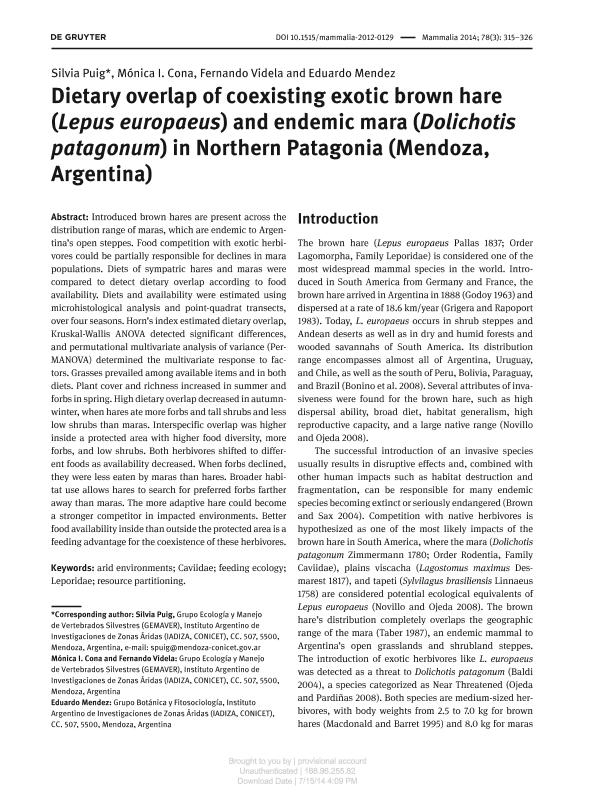Artículo
Dietary overlap of coexisting exotic brown hare (Lepus europaeus) and endemic mara (Dolichotis patagonum) in Northern Patagonia (Mendoza, Argentina)
Fecha de publicación:
07/2014
Editorial:
De Gruyter
Revista:
Mammalia
ISSN:
0025-1461
Idioma:
Inglés
Tipo de recurso:
Artículo publicado
Clasificación temática:
Resumen
Introduced brown hares are present across the distribution range of maras, which are endemic to Argentina’s open steppes. Food competition with exotic herbivores could be partially responsible for declines in mara populations. Diets of sympatric hares and maras were compared to detect dietary overlap according to food availability. Diets and availability were estimated using microhistological analysis and point-quadrat transects, over four seasons. Horn’s index estimated dietary overlap, Kruskal-Wallis ANOVA detected significant differences, and permutational multivariate analysis of variance (PerMANOVA) determined the multivariate response to factors. Grasses prevailed among available items and in both diets. Plant cover and richness increased in summer and forbs in spring. High dietary overlap decreased in autumn-winter, when hares ate more forbs and tall shrubs and less low shrubs than maras. Interspecific overlap was higher inside a protected area with higher food diversity, more forbs, and low shrubs. Both herbivores shifted to different foods as availability decreased. When forbs declined, they were less eaten by maras than hares. Broader habitat use allows hares to search for preferred forbs farther away than maras. The more adaptive hare could become a stronger competitor in impacted environments. Better food availability inside than outside the protected area is a feeding advantage for the coexistence of these herbivores.
Palabras clave:
Arid Environments
,
Caviidae
,
Feeding Ecology
,
Leporidae
,
Resource Partitioning
Archivos asociados
Licencia
Identificadores
Colecciones
Articulos(IADIZA)
Articulos de INST. ARG DE INVEST. DE LAS ZONAS ARIDAS
Articulos de INST. ARG DE INVEST. DE LAS ZONAS ARIDAS
Citación
Puig, Silvia; Cona, Monica Ines; Videla, Fernando; Mendez, Eduardo; Dietary overlap of coexisting exotic brown hare (Lepus europaeus) and endemic mara (Dolichotis patagonum) in Northern Patagonia (Mendoza, Argentina); De Gruyter; Mammalia; 78; 3; 7-2014; 315-326
Compartir




